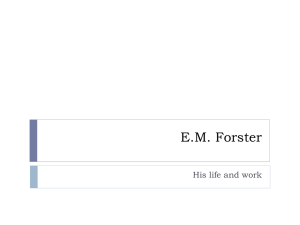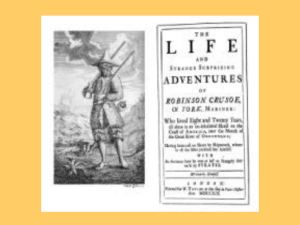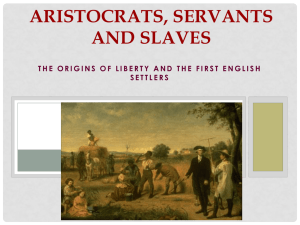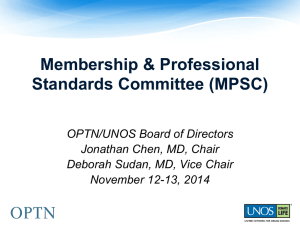V Bainbridge handout 1
advertisement
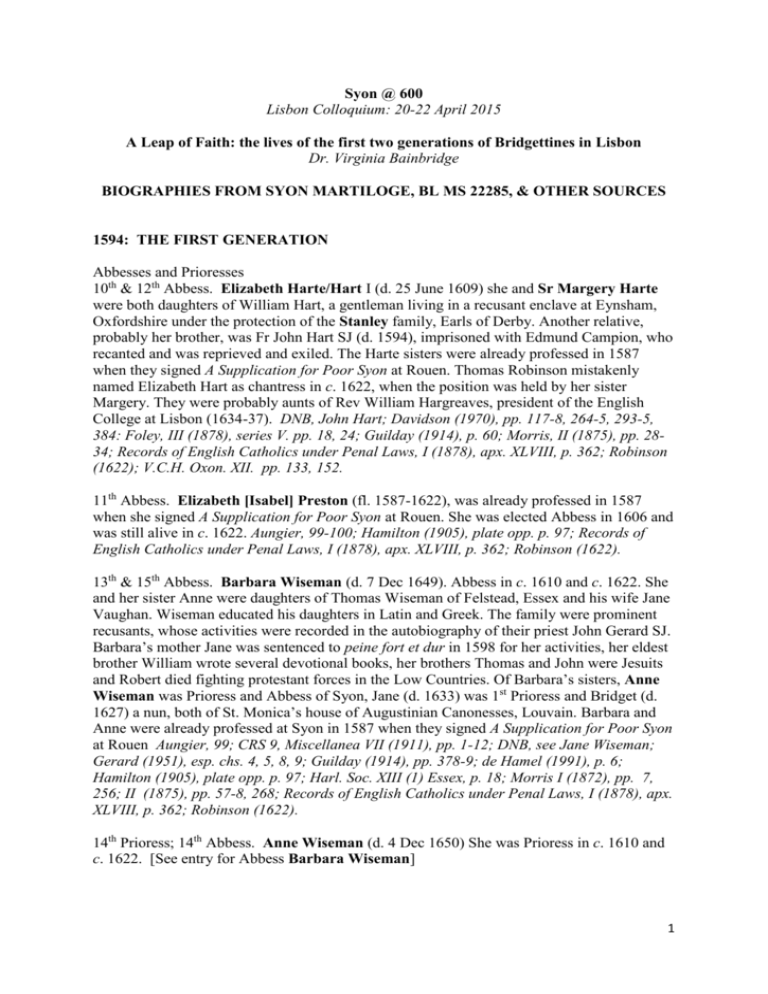
Syon @ 600 Lisbon Colloquium: 20-22 April 2015 A Leap of Faith: the lives of the first two generations of Bridgettines in Lisbon Dr. Virginia Bainbridge BIOGRAPHIES FROM SYON MARTILOGE, BL MS 22285, & OTHER SOURCES 1594: THE FIRST GENERATION Abbesses and Prioresses 10th & 12th Abbess. Elizabeth Harte/Hart I (d. 25 June 1609) she and Sr Margery Harte were both daughters of William Hart, a gentleman living in a recusant enclave at Eynsham, Oxfordshire under the protection of the Stanley family, Earls of Derby. Another relative, probably her brother, was Fr John Hart SJ (d. 1594), imprisoned with Edmund Campion, who recanted and was reprieved and exiled. The Harte sisters were already professed in 1587 when they signed A Supplication for Poor Syon at Rouen. Thomas Robinson mistakenly named Elizabeth Hart as chantress in c. 1622, when the position was held by her sister Margery. They were probably aunts of Rev William Hargreaves, president of the English College at Lisbon (1634-37). DNB, John Hart; Davidson (1970), pp. 117-8, 264-5, 293-5, 384: Foley, III (1878), series V. pp. 18, 24; Guilday (1914), p. 60; Morris, II (1875), pp. 2834; Records of English Catholics under Penal Laws, I (1878), apx. XLVIII, p. 362; Robinson (1622); V.C.H. Oxon. XII. pp. 133, 152. 11th Abbess. Elizabeth [Isabel] Preston (fl. 1587-1622), was already professed in 1587 when she signed A Supplication for Poor Syon at Rouen. She was elected Abbess in 1606 and was still alive in c. 1622. Aungier, 99-100; Hamilton (1905), plate opp. p. 97; Records of English Catholics under Penal Laws, I (1878), apx. XLVIII, p. 362; Robinson (1622). 13th & 15th Abbess. Barbara Wiseman (d. 7 Dec 1649). Abbess in c. 1610 and c. 1622. She and her sister Anne were daughters of Thomas Wiseman of Felstead, Essex and his wife Jane Vaughan. Wiseman educated his daughters in Latin and Greek. The family were prominent recusants, whose activities were recorded in the autobiography of their priest John Gerard SJ. Barbara’s mother Jane was sentenced to peine fort et dur in 1598 for her activities, her eldest brother William wrote several devotional books, her brothers Thomas and John were Jesuits and Robert died fighting protestant forces in the Low Countries. Of Barbara’s sisters, Anne Wiseman was Prioress and Abbess of Syon, Jane (d. 1633) was 1st Prioress and Bridget (d. 1627) a nun, both of St. Monica’s house of Augustinian Canonesses, Louvain. Barbara and Anne were already professed at Syon in 1587 when they signed A Supplication for Poor Syon at Rouen Aungier, 99; CRS 9, Miscellanea VII (1911), pp. 1-12; DNB, see Jane Wiseman; Gerard (1951), esp. chs. 4, 5, 8, 9; Guilday (1914), pp. 378-9; de Hamel (1991), p. 6; Hamilton (1905), plate opp. p. 97; Harl. Soc. XIII (1) Essex, p. 18; Morris I (1872), pp. 7, 256; II (1875), pp. 57-8, 268; Records of English Catholics under Penal Laws, I (1878), apx. XLVIII, p. 362; Robinson (1622). 14th Prioress; 14th Abbess. Anne Wiseman (d. 4 Dec 1650) She was Prioress in c. 1610 and c. 1622. [See entry for Abbess Barbara Wiseman] 1 12th & 13th Prioress. Ursula Hoorde (d. 9 June 1598) was prioress in 1587 when she signed A Supplication of Poor Syon at Rouen. Her family was part of the English clerical and intellectual elite, both before and after the Reformation. Ursula was the daughter of Alan Hoorde (d. 1554), a powerful lawyer of the Middle Temple, who had lands in Shropshire, at Ewell, Surrey, and in other counties. Her mother was Dorothy (d. 1577) daughter of Thomas Roberts of Willesden, Middlesex. Alan’s brother Edmund Hoorde, Dr of Canon Law and fellow of All Souls’ College, Oxford, was prior of Hinton Charterhouse, Somerset, at its dissolution. He was reluctant to accept the Royal Supremacy or surrender the house, but did so after being advised of the consequences of refusal by his brother. Sr Amea Herd or Hord was Ursula’s great-aunt and the family was intermarried with the Buckley, Charlton, Palmer, Stapleton, Sulyard and Tyrell families, which also produced Syon vocations. Members of the Hoorde family were heavily involved in the Catholic resistance in the later 16th century. In 1579 Ursula Horde was recorded attending a Mass given by one Master Sutton, formerly of Trinity College, Oxford. William Hoorde, who was imprisoned with Sr Elizabeth Sander in 1580 for distributing Campion’s Challenge and later helped her to escape, came from the Hampshire branch of the family. His father Roger Hoord (d. 1580) came from Shrewsbury, Shropshire, and was verger of Winchester cathedral. He was educated at Winchester school, to which he left his copies of the Church fathers, including Origen and Tertullian and his son William was also educated there. Cal. S. P. Dom. 1547-80, p. 688; Davidson (1970), 178, 256-9, 409; Fletcher XII. pp. 58-60; Harl. Soc. XLII. Surrey, pp. 222-23; Hutchison (1993), p. 281-2; Knowles III (1959), p. 238; Records of English Catholics under Penal Laws, I (1878), apx. XLVIII, p. 362. Other Sisters Sander/Sanders, Elizabeth, (d. 1 Aug. 1607) she, her elder sister, Prioress Margaret, and Dr. Nicholas Sanders SJ (d. 1581), Roman Catholic apologist, were the children of William and Elizabeth Sanders of Aston, Surrey. Elizabeth was one of the younger nuns sent back to England for safety and to help raise funds, when the community was approaching starvation in 1578. She seems to have returned to England alone to avoid suspicion and was in London for a short time, before she went to stay with members of her family. In 1580 she helped to distribute Campion’s Brag or Challenge, which drew attention to Catholics. She was twice arrested and imprisoned, but escaped both times and after many adventures, returned to her community at Rouen in 1587, and signed A Supplication for Poor Syon. Her survival for so long shows her resilience and resourcefulness and also the strength of Recusant family networks. She was buried in the Lower Choir of the Sisters at Lisbon. CRS, V (1908) 14042; Gillow, V. 475; Hutchison (1993) 268-272; Records of English Catholics under Penal Laws, I (1878), apx. XLVIII, p. 362. Aliaga, Angela (d. 5 Oct. 1597) was already professed in 1587 when she signed A Supplication for Poor Syon at Rouen. She was buried at Lisbon. Aungier, 109; Records of English Catholics under Penal Laws, I (1878), apx. XLVIII, p. 362. Harte/Hart, Margery (d. 23 July 1628) Chantress in c. 1610 and 1622. She and Abbess Elizabeth were both daughters of William Hart, a gentleman living in a recusant enclave at Eynsham, Oxfordshire under the protection of local landowners, the Stanley family, Catholic earls of Derby. Another relative, probably her brother, was Fr John Hart SJ (d. 1594), imprisoned with Edmund Campion, but reprieved and exiled. The Harte sisters were already professed in 1587 when they signed A Supplication for Poor Syon at Rouen. Thomas Robinson mistakenly named Elizabeth Hart as chantress in c. 1622, when this office was held by Margery. They were probably aunts of Rev. William Hargreaves, president of the English 2 College at Lisbon (1634-37). Aungier, 99-100; Davidson (1970), pp. 117-8, 264-5, 293-5, 384: Foley, III (1878), ser. v. pp. 18, 44; Guilday (1914), p. 60; Hamilton (1905) plate opp. p. 97; Morris, II (1875), pp. 28-34; Records of English Catholics under Penal Laws, I (1878), apx. XLVIII, p. 362; Robinson (1622); V.C.H. Oxon. XII. pp. 133, 152. Markinfeld [Markenfield], Anne (d. 10 Aug. 1626) She probably came from the Markenfield family of Yorkshire, which was intermarried with the Conyers family. She was already professed in 1587 when she signed A Supplication for Poor Syon at Rouen. She died at Lisbon. Aungier, 99-100; Hamilton (1905), plate opp. p. 97; Harl. Soc. XVI. Yorks. pp. 196-7; Records of English Catholics under Penal Laws, I (1878), apx. XLVIII, p. 362; Robinson (1622). Greenwood/Grenwode, Joanna (d. 27 Aug. 1607) she came from the Greenwood family which was descended from St Thomas More. There were branches in Oxfordshire and Yorkshire. She was already professed in 1587 when she signed A Supplication for Poor Syon at Rouen. She was buried in the Sisters’ lower choir, Lisbon. Harl. Soc. V. Oxon. p. 256; Records of English Catholics under Penal Laws, I (1878), apx. XLVIII, p. 362. Arundell, Cicily (d. 25 Feb. 1623) She was probably the daughter of Sir John Arundell of Lanherne, Cornwall (d. 1590), and his wife Lady Anne, daughter of Edward Stanley, Earl of Derby. Sir John’s household at Lanherne, a centre of Cornish recusancy, was forcibly dispersed in 1579, after the capture of the priest St Cuthbert Mayne. Sir John remained under house arrest for the rest of his life. He died at his house at Brentford, Middlesex and was buried at Isleworth. Cicily’s sisters Dorothy (d. 1613), and Gertrude originally intended to join the Bridgettines, but Dorothy had a vision of her martyred confessor, Fr John Cornelius, which inspired them to enter the new Benedictine convent at Brussels in 1600. Charles Arundell, probably a cousin, was a prominent member of an association of young English catholics. She was already professed in 1587 when she signed A Supplication for Poor Syon at Rouen. Aungier, 99-100; Burke, Peerage, Baronetage and Knightage (1878), 46-7; DNB, see Dorothy Arundell and Arundell family; Fletcher, XII. p. 46; Hamilton, plate opp. p. 97; Howard and Burke, Genealogical Collections, iii (1887), pp. 191-3, 229; Hutchison, (1993), pp. 271, 282; Morris/ Foley [add info]; Records of English Catholics under Penal Laws, I (1878), apx. XLVIII, p. 362; Robinson (1622). Martin, Anne (d. 16 Feb. 1629) was already professed in 1587 when she signed A Supplication for Poor Syon at Rouen. She was buried in the Sisters’ lower Choir at Lisbon. Aungier, 99-100; Records of English Catholics under Penal Laws, I (1878), apx. XLVIII, p. 362; Robinson (1622). Shelton, Elizabeth (d. 6 Feb. 1625) was already professed in 1587 when she signed A Supplication for Poor Syon at Rouen. Hamilton (1905), plate opp. p. 97; Records of English Catholics under the Penal Laws, I (1878), apx. XLVIII, p. 362; Robinson (1622). Berrige [Birrige], Grace (d. 26 July 1626) was already professed in 1587 when she signed A Supplication for Poor Syon at Rouen. She died at Lisbon. Records of English Catholics under Penal Laws, I (1878), apx. XLVIII, p. 362. Gerard [Gerrat], Elizabeth (d. 19 Aug. 1607) was already professed in 1587 when she signed A Supplication for Poor Syon at Rouen. She died at Lisbon. Records of English Catholics under Penal Laws, I (1878), apx. XLVIII, p. 362. 3 Wharton, Anne (d. 5 Jan 1632) was already professed in 1587 when she signed A Supplication for Poor Syon at Rouen. She was Treasurer in c. 1622, and died at Lisbon. Aungier, 99-100; Hamilton (1905), plate opp. p. 97; Records of English Catholics under Penal Laws, I (1878), apx. XLVIII, p. 362; Robinson (1622). Tychburne, Maxia [Mary] (d. 6 Oct. 1614) came from a family of prominent recusants with lands in Hampshire and neighbouring counties. She was already professed in 1587 when she signed A Supplication for Poor Syon at Rouen. She was buried in the sisters’ lower choir at Lisbon. Hutchison (1993), pp. 280, 282; Morris, I (18--), ch. ix; ibid. ii (18--), p. 143; Records of the English Catholics under Penal Laws, I (1878), apx. XLVIII, p. 362. Shelley, Francisca (d. 14 July 1594) came from a family of prominent recusants with lands in Hampshire and neighbouring counties. She was already professed in 1587 when she signed A Supplication for Poor Syon at Rouen. She was buried at the Convent of Discalced Carmelites, Lisbon. Records of English Catholics under Penal Laws, I (1878), apx. XLVIII, p. 362. [Fowler, Dorothea (d. ?? Oct 1615) was already professed in 1587 when she signed A Supplication for Poor Syon at Rouen. She was Keeper of the Relics in c. 1622. Aungier, 99100; Hamilton (1905), plate opp. p. 97; Records of English Catholics under Penal Laws, I (1878), apx. XLVIII, p. 362; Robinson (1622). Either She may have been descended from the Fowler family of Rycote, Oxfordshire, Special Benefactors of Syon, who were intermarried with the Windsor family. Sr Margaret Windsor (d. 1643), was her contemporary at Syon. Harl. Soc. V. Oxon. pp. 187; Ibid. XIX. Beds. pp. 29-30; Macnamara (1895), pp. 155, 170-171, pedigree facing p. 171, 208-9. Or She may have been related to John Fowler (1537-79), who was one of several Catholic fellows of New College, Oxford, with links to Syon, who resigned on Elizabeth I’s accession. At Louvain this group of scholars continued to work together and Fowler became an important editor and publisher of English recusant books. His wife Alice (d. 1602), continued his work after his death. Margaret Fowler (d. 1656), professed as Sr Clare of St John at St Omer in 1593 aged 19, and a founder member of the English convent of Poor Clares at Gravelines, may also have been related. DNB, see John Fowler; CRS 14 (1914), pp. 25, 823; Southern (1950), pp. 342-4. Not in Martiloge.] Johnson, Margaret/Mary (d. 8 Nov. 1613) joined the community after 1587. She was probably related to Sr Lucy Johnson. She was buried in the Sisters’ lower choir. Fletcher MSS check ref. Lay Sister. Terrel [Tyrrell], Gertrude (d. Lisbon 29 July 1598). Sir Thomas Tyrrell of Heron, Essex married Constance, daughter of Lord Mountjoy. Their eldest son John married Anne, daughter of Sir William Browne, Lord Mayor of London, sister of Abbess Constance Browne. Anne’s second husband was Sir William Petre, member of an Essex recusant family. The Tyrrells were devout Roman Catholics, who were favoured by Queen Mary, and the 4th son George, took his family into exile because of his faith. In c. 1574 his daughter Gertrude entered Syon Abbey, the only English house of nuns at that time, where she followed her vocation with great conviction. She signed A Supplication for Poor Syon at Rouen in 1587. Her brother Fr Anthony Tyrrell, ‘four times a Catholic & three times a Protestant’, betrayed many of his friends and relations under torture after the Babington Plot, including a number related to other Syon nuns. Aungier, 102-3; Harl Soc. XIII. Essex (1878), 4 pp. 15-16; Morris, II (1875), ii. esp. 291-5, 364-5; Records of English Catholics under Penal Laws, I (1878), apx. XLVIII, p. 362. Novice. [Shelley, Dorothy. (d. 16 Sept 1608) came from a family of prominent recusants with lands in Hampshire and neighbouring counties. She was related to Sr Frances Shelley and arrived in Lisbon as a novice in 1594. She may have taken the name Magdalene in religion, and be the lay sister identified as a kitchener in c. 1622. Aungier, *98; Robinson (1622). Not in Martiloge.] * 12th Confessor General. Seth, alias Joseph Forster/Foster (d. 24 May 1628) The gentry family of Forster had many branches in the northern counties. According to Foley, Seth Forster was from Earswick, Yorkshire. His father John Forster was imprisoned for recusancy before 1580 in York Castle and he and his wife and daughter-in-law, Isabel (neé Langley d. 1585) later died there. Isabel was a wife of Seth Forster’s elder brother, William Forster of Earswick (d. in or before 1618). Seth’s brother William was said to have been converted to Rome by a relative, Fr Richard Holtby SJ. Afterwards, William too was imprisoned at York and having made his property over to his eldest son, Richard Forster (c.1585-1661), he went abroad with his other children and died in exile at Antwerp. William’s son Thomas Forster SJ (c.1590-1648) returned to Yorkshire as a missionary in 1616. In 1646 Thomas was imprisoned by Parliamentary forces in Lincoln Gaol, where he died. William’s daughter Sr Clare Dowman, alias Forster was a nun at Syon by c.1610. Seth Forster studied for an MA at Douai. Cardinal Allen later sent him to help found the English College at Rome and he received a pension from the Pope. Forster helped the Syon community find a convent at Rouen. He was persuaded to become their confessor-general and was elected on 8th March 1584. He was well-educated, able and well-connected, qualities which were vital to Syon’s survival in the late 1500s and early 1600s. Shortly after his election, he was said to have been saved from death by poisoning, by the prayers of Sr Gertrude Tyrell. After his recovery, he recruited 4 new English priests and attracted patronage from the King of France. When Frs John Marsh and John Vivian, two of Syon’s priests were captured on a fund-raising mission, Forster was able to use his contacts to get them released from gaol. Once the siege of Rouen was over, he arranged Syon’s passage to Portugal and negotiated a pension from the King of Spain. He realised the importance of publicity in attracting funds and wrote a history of Syon’s wanderings, which was reproduced in various forms, starting as a fund-raising pamphlet, A Supplication of Poor Syon, addressed to all well-disposed Catholics in 1587. An illuminated version was made as a gift for the Spanish Infanta, when her marriage to the future Charles I seemed likely. After the Spanish match failed, Forster probably used his nephew Richard Forster, a courtier and financier, to gain influence and to secure a regular flow of vocations. Queen Henrietta Maria was known to have a devotion to St Bridget and Richard later joined her household. Fr Forster was significant enough for Thomas Robinson to write a scurrilous pamphlet about him in 1622, implying, amongst other things, improper relations with Abbess Elizabeth Preston. It also suggested that he made shrewd investments with Portugese merchants, which kept Syon afloat financially. A portrait of him aged 60, adoring a crucifix, is the property of Syon Abbey, South Brent, Devon. Aungier, 99-112, *110; Cal. SP Dom. Chas I (VII), p. 125; D.N.B., see Richard Forster, Richard Holtby; Foley III. 5th ser. pp. 3-17; ibid. 6th ser. pp. 188-9; Fuller, II (1837), p. 285; Gillow, II. see Thomas, alias Seth Forster; Hamilton (1905), pp. 97-113; de Hamel (1991) ; Records of English Catholics under Penal Laws, I (1878), apx. XLVIII, p. 362; Robinson (1622). 5 Priests Marsh [Mush], John, Sir (d. 18 Nov. 1601) was born in Yorkshire, where he was later a missionary priest and spiritual director of a group of devout lay people, including St Margaret Clitherow, a martyr for her faith and Fr Seth Forster/Foster’s mother who died in harsh prison conditions at York along with several others. Marsh wrote an account of the sufferings of Catholics in Northern England, and a Life of Margaret Clitherow. He was imprisoned with them at York in 1585 and sentenced to death. He was transferred to the Castle at Hull and transported to Newhaven in Normandy in a shipment of priests, who were banished to clear overcrowded jails. He went to Rome (Aungier) / Rheims (Fletcher) where he gave Forster a personal account of his mother’s death. As Confessor-general, Forster recruited four new priests. Marsh was one of three preachers among them and was an approved confessor for English exiles in Flanders. He signed A Supplication for Poor Syon at Rouen in 1587. In that year Forster sent Marsh and Fr John Vivian to Spain to collect Syon’s pension. On their return voyage, they were robbed and imprisoned at La Rochelle. They were taken away by the pirate Nichols as traitors to the Queen and nearly starved to death. In England they were imprisoned in the Marshalsea, but Forster arranged for their release through the governor of Rouen, a friend of Sir Francis Walsingham. Marsh returned to the Syon community at Rouen in 1588. He died peacefully at Lisbon. Fletcher puts forward an alternative genealogy, suggesting he was a member of the March family of Cambridgeshire, who studied at the English college at Rheims, was ordained deacon and priest in 1579 and sent on the English mission in 1580. Aungier, 103, 105,465-6; Challoner, Memoirs of Missionary Priests, I. p. 189 - reread; Dodd’s Church History, II. p.115- check; Fletcher XII. pp. 186-7; Records of English Catholics under Penal Laws, I (1878), apx. XLVIII, p. 362; Morris, III. (1877), iv., v. – check pages; J. Hirst, ‘The Blockhouses of Hull’, p. 80 - check. Vivianus [Vivian], John, Master (d. 10 April 1624) came from Dorset and studied at Douai College. He returned to England as a missionary in 1579. After several years he was captured and imprisoned and in 1585 he was banished from the realm. Around this time Vivian was recruited by Fr Foster, as one of four new priests and one of three preachers for Syon. He signed A Supplication for Poor Syon at Rouen in 1587. In that year Foster sent Vivian and Fr John Marsh to Spain to collect Syon’s pension. On their return voyage, they were robbed and imprisoned at La Rochelle. They were taken away on the ship of the pirate Nichols as traitors to the Queen and nearly starved. In England they were imprisoned in the Marshalsea, but Fr Foster arranged for their release through a friend of Sir Francis Walsingham. Aungier, 103, 105; Foley, III (1878), v. p. 43; Oliver, II (1857), p. 429; Records of English Catholics under Penal Laws, I (1878), apx. XLVIII, p. 362; Robinson (1622). Kempe, David, Sir (d. 28 Feb. 1615). Shortly after Fr Foster became Confessor-general in 1584, he recruited 4 new priests. Mr David Kempe was one of three preachers among them. He was not a signatory to A Supplication of Poor Syon in 1587. Aungier, 103. [Barras [Barrowes], Nicholas (d. 7 Oct. 1621), came from the Durham family of Barras and was educated at the English College of Rheims. He received minor orders on 23 Sept. 1583 and was ordained priest on 31 March 1584 in the Chapel of the Great Crucifix, Rheims Cathedral, by Cardinal a Guysia. He was professed at Rouen in 1585 and signed A Supplication of Poor Syon in 1587. He died at Lisbon. Aungier, 99-100; Fletcher, xii. p. 1856; Records of English Catholics under Penal Laws, I (1878), apx. XLVIII, p. 362; Robinson (1622); check records of College of Rheims. Not in Martiloge.] 6 Lay brothers Gowar/Gore, Thomas (d. 29 June 1614). Shortly after Fr Seth Foster became Confessorgeneral in 1584, he recruited four new brothers, including Mr. Thomas Gore, a vocary. Gore signed A Supplication of Poor Syon in 1587. He died at Lisbon. Aungier, 103; Records of English Catholics under Penal Laws, I (1878), apx. XLVIII, p. 362. Consul, Peter (d. 10 Dec. 1634) joined the community after 1587, and came to Lisbon in 1594. He was the only lay brother in c. 1622. Aungier, 99-100; Fletcher, XII. p. 192; Robinson (1622). * * * 1594 – c. 1622: THE SECOND GENERATION [Bacon, Susan. She was professed by c. 1610 and was still alive in c. 1622. Aungier, 99100; Hamilton, plate opp. p. 97; Robinson (1622). Not in Martiloge.] Barnes, Mary (d. 1 March 1625) was professed in 1604 and was still alive in c. 1622. Fletcher MSS, check ref; Aungier, 99-100; Hamilton, plate opp. p. 97; Robinson (1622). [Becket, alias Smith, Margaret. She was professed by c. 1610 and was still alive in c. 1622. Several nuns with the surname Smith are recorded at early 17th century Syon. Aungier, 99100; Hamilton, plate opp. p. 97; Robinson (1622). Not in Martiloge.] [Beckett, alias Smith, Gertrude. She was living at Syon by c. 1610 and was still alive in c. 1622. Hamilton, plate opp. p. 97; Robinson (1622). Not in Martiloge.] [Bingham, Anne, alias Josepha (d. 1635) was professed in 1609 and was Portress in 1622. Thomas Robinson suggests her vocation was encouraged by Fr Garnett SJ, who lived at her mother’s house in England. Fletcher MSS check ref; Aungier, 99-100; Hamilton, plate opp. p. 97; Robinson (1622), p. 15. Not in Martiloge.] [Blenkinsop [Blinksop], Dorothea (d. 1643) was professed in 1618. Thomas Robinson said that M. Blinksop was ‘allied to diverse of the Nobility’. Aungier, 99-100; Fletcher MSS check ref; Robinson (1622), pp. 31-2. Not in Martiloge.] [Brook, Barbara (d. 1678) was living at Syon by c. 1610 and was professed in 1618. She may have taken the name Mary in religion, and be identified as a chorister in c. 1622. Aungier, 99-100; Fletcher MSS check ref. Hamilton, plate opp. p. 97; Robinson (1622). Not in Martiloge.] [Brook, Mary. She was a chorister in c. 1622. Mary may be the name Barbara Brook took in religion. Aungier, 99-100; Robinson (1622). Not in Martiloge.] [Browne, Bridget. She and her sister Lucy were living at Syon by c.1610 and were still alive in 1622. Anne, one of their father’s chambermaids had also become a nun at Syon. The sisters were daughters of Anthony Maria Browne (1574-1629), 2nd Viscount Montagu and his wife Jane Sackville (d. 1652). Browne gave Syon a donation of over £2000. The sisters’ paternal grandmother was Mary Dormer, a granddaughter of Lady Joanna Dormer, patron 7 of Syon. Their great aunt was Jane Dormer, duchess of Feria, an important link between English Catholics and the Spanish court. Their grandfather Sir Anthony Browne (c.1528-92), 1st Viscount Montagu, was chancellor to Queen Mary. He and his 2nd wife Magdalene founded a dynasty of influential Roman Catholics. The family’s main estates were in Sussex, and they were part of an extensive network of recusants and sympathizers. The 1st Viscount’s daughter Mary was married to Henry Wriothesley, 2rd Earl of Southampton, whose family had links with Syon, and her half-sister Elizabeth was married to Sir Robert Dormer, another grandchild of Lady Joanna Dormer. Bridget and Lucy’s brother Francis (1610-1682), later 3rd viscount Montagu, was educated abroad in the early 1620s, and other siblings and cousins followed religious vocations abroad. Aungier, 99-100; Clifford (1887), pp. 8-12; Complete Peerage, ix. pp. 97-101; DNB, see Browne; Hamilton (1905), plate opp. p. 97; Harl. Soc. LVI. Berks. i. p. 76; Questier (2006), pp. 332-3; Robinson (1622), pp. 10, 31-2; Southern (1954). Not in Martiloge] [Browne, Lucy (d. 1653) was professed in 1614. [See entry for Sr Bridget Browne] Fletcher MSS check ref. Not in Martiloge.] [Colbecke, Ursula. She was professed by c. 1610, but had probably died by c. 1622. Hamilton, plate opp. p. 97. Not in Martiloge.] [Doman, alias Forster, Clare (d. 1627) was professed in 1609. She came from a prominent Yorkshire recusant family. Her father was William Forster of Earswick (d. in or before 1618), who was converted to Rome by his relative, Fr Richard Holtby SJ. Her grandfather John Forster was imprisoned for recusancy before 1580 in York Castle and he and his wife and one of William Forster’s wives, Isabel (neé Langley d. 1585) died there. William too was later imprisoned at York and after making his property over to his eldest son Richard Forster (c.1585-1661), went abroad with his other children and died at Antwerp. William’s brother was Fr Seth Forster, confessor-general of Syon, and several of William’s children followed religious vocations. Clare was professed at Syon by c. 1610. Two brothers became Jesuits, Seth Forster SJ and Thomas Forster SJ (c.1590-1648) who returned to the Yorkshire mission in 1616 and was imprisoned by Parliamentary forces in Lincoln Gaol in 1646, where he died. Her eldest brother Richard Forster used his position at court to help English Catholics and her cousin Sr Frances Holtby was her contemporary at Syon. Fletcher MSS, check ref; Aungier, 99-100, *110; Cal. SP Dom. Chas I (VII), p. 125; D.N.B., see Richard Forster; Foley, III (1878), 5th ser. pp. 3-17; ibid. 6th ser. pp. 188-9; Fuller, II (1837), p. 285; Gillow, II. see Thomas, alias Seth Forster; Hamilton (1905), plate opp. p. 97; Robinson (1622). Not in Martiloge.] Dutton, Elionora, alias Francisca (d. 12 Jan. 1617) died at Lisbon. No more information yet. [Dymoke/Dimmock, Mary. She was a young nun in c. 1622. Aungier, 99-100; Burke, Landed Gentry, I (1871), pp. 382-3; DNB, see Dymoke; Robinson (1622). Not in Martiloge] Dymoke/Dimmock, Priscilla (d. 30 Nov. 1647) was professed by c. 1610 and died at Lisbon. She may have taken the name Mary in religion, and be identified as Mary Dymoke, a young nun in c. 1622. She probably came from the Dymoke family of Lincolnshire, which had another branch in Norfolk. After the Reformation, the family remained Roman Catholic. Fr Charles Dymoke was 14th Confessor-general (1659-62). Aungier, 99-100, 110; Burke, 8 Landed Gentry, I (1871), pp. 382-3; DNB, see Dymoke; Fletcher, XII. pp. 54-5; Gillow, English Catholics; Hamilton (1905), plate opp. p. 97; Robinson (1622). [Hildisly, Agatha (d. 1628) was living at Syon by c. 1610 and was professed in 1618. She was probably the Sr Agatha, whose surname was unknown to Thomas Robinson in c. 1622. Aungier, 99-100; Fletcher MSS check ref; Hamilton, plate opp. p. 97; Robinson (1622). Not in Martiloge.] [Houltby [Holtby], Frances. She was living at Syon by c. 1610 and was professed in 1620. She was probably from a Yorkshire gentry family, many of whom were Roman Catholic. Fr Richard Holtby SJ is perhaps the best-known member of the family, active in the English Mission in the later 16th century. He encouraged his relatives in the Catholic faith. Three of his nephews, George and Robert Holtby and Seth Foster, became Jesuits and his niece Sr Clare Dowman was at Syon with Frances. Fletcher MSS check ref; Foley, III (1878), pp. 316; Hamilton, plate opp. p. 97. Not in Martiloge] Johnson, Lucy (d. 23 Feb. 1627) Fr Seth Forster’s nephew Richard Forster (c. 1585-1661) used the alias Johnson, which suggests Lucy and Sr Margaret/Mary Johnson may have been part of Fr Forster’s extended family. She was living at Syon by c. 1610 and was Notaress in c. 1622. Aungier, 99-100; DNB, see Richard Forster alias Johnson; Hamilton, plate opp. p. 97; Robinson (1622). [Knyghtly, Katharine (d. 1664) was living at Syon by c. 1610 and was professed in 1612. She was a chorister in c. 1622. Fletcher MSS check ref; Aungier, 99-100; Hamilton, plate opp. p. 97; Robinson (1622). Not in Martiloge.] Lucas, Helen (d. 31 March 1626) was professed by c. 1610, and may have been listed as Elianor, a Dutch woman in c. 1622. Aungier, 99-100; Hamilton, plate opp. p. 97; Robinson (1622). [Salisbury, Clare (d. 1671) was living at Syon by c. 1610 and was professed in 1618. Fletcher MSS check ref; Hamilton (1905), plate opp. p. 97. Not in Martiloge.] [Smithe/Smith, Bridget. She was living at Syon by c. 1610. Several nuns with the surname Smith are recorded at early 17th century Syon. Two sisters, Joyce and Judith Smith, travelled from London to Lisbon in 1612/13. Thomas Robinson lists two sisters with the surname Smith, alias Becket, Margaret and her sister Gertrude in c. 1622. Some of these women may have been related to Fr William Smith, 14th confessor-general. Aungier, 99-100; Hamilton (1905), plate opp. p. 97; Robinson (1622); inf. From Dr. Glyn Redworth – check ref. Not in Martiloge.] [Sharpley, Martha (d. 1649). She was professed in 1607. She is probably listed as Martha in c. 1622. Fletcher MSS check ref; Aungier, 99-100; Robinson (1622). Not in Martiloge] Vincent, Afra (d. 12 June 1605) buried at Lisbon. No more information yet. Wilson, Dorothy (d. 16 Aug. 1637) was living at Syon by c. 1610 and was professed in 1621. Fletcher MSS check ref; Hamilton (1905), plate opp. p. 97. 9 [Windsor, Margaret (d. 1643) was living at Syon by c. 1610 and was professed in 1621. She probably came from the same family as Sr Margaret Windsor, 9th Prioress. The Windsor family retained Roman Catholic sympathies after the Reformation. Fletcher MSS check ref; Aungier, 99-100; Hamilton (1905), plate opp. p. 97. Not in Martiloge.] Lay Sisters & servants etc [Allayne, Mary (d. 1646) was professed in 1609 and died in 1646. Fletcher MSS check ref. Not in Martiloge.] [Cole, Elizabeth. She was one of three kitcheners in c. 1622. Aungier, 99-100; Robinson (1622). Not in Martiloge.] Dendi, Catherine (d. 20 Jan 1639) was probably Portugese. She was professed in 1607 and was of three kitcheners in c. 1622. She died in 1639. Aungier, 99-100; Fletcher MSS check ref; Robinson (1622). Gatyfers [Galyers], Angela (d. 5 March 1625/35) was professed in 1607, and may have been listed as Angela, a Dutch woman, in c. 1622. Aungier, 99-100; Fletcher MSS check ref; Robinson (1622). Shelley, Magdalena (d. 3 June 1635) came from the same family of prominent recusants with lands in Hampshire and neighbouring counties as Sr Frances Shelley. She was professed in 1607. She was one of three kitcheners in c. 1622. She may be identified with Dorothy Shelley, a novice in 1594, if she had taken the name Magdalene in religion. Fletcher MSS check ref; Aungier, 99-100; Robinson (1622). Anne – a chambermaid of Sir Anthony Browne. Three Portugese Sisters 16th abbess. Birgitta Mendanha Lusitana. She was living at Syon by c. 1610, and was one of three Portugese sisters in c. 1622. She was the Portugese heiress who gave the community her inheritance, worth 400 Milreas a year. A portrait of her on her death-bed is the property of Syon Abbey, South Brent, Devon. Aungier, 99-100; Fuller, Church History II (1837), p. 284; Hamilton (1905), plate opp. p. 97; Robinson (1622). [Rodriguez, Maria. She was one of three Portugese sisters in c. 1622. Aungier, 99-100; Robinson (1622). Not in Martiloge.] [Suarez/Soarez, Maria. She was professed in 1618 and was one of three Portugese sisters in c. 1622. Fletcher MSS check ref; Aungier, 99-100; Robinson (1622). Not in Martiloge.] Virginia.bainbridge123@btinternet.com 10
